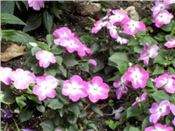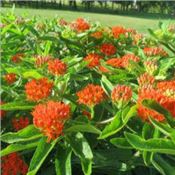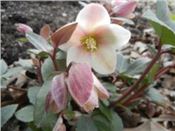Gardening Page
What determines if a plant is called a perennial or an annual?
Annuals and Perennials
A plant that is sold as an annual is one that completes its life cycle in one season. Think of a impatien, marigold, or even a tomato plant.
We plant them after all chances of frost have passed, then they grow during the warm months and die with a killing frost. These would be called warm season annuals—growing from start to finish basically from frost to frost, during the warmer months of the year. Pansies and violas, lettuce and radishes, would be considered cool season annuals, with planting dates either in the fall or late winter. They would die with the onset of hot weather.
A perennial is a plant that lives for more than one year. Some perennials like daylilies, asparagus and hosta die back completely to the ground after a killing frost in the fall, and begin new growth in the spring. Other perennials like hellebores (Lenten rose), rosemary and lambs ear are evergreen, but live from year to year. Some perennials are very long lived like peonies and ferns, while others are relatively short lived like dianthus and foxglove.
Most perennials are non-woody. They have a season of dormancy, and a few are evergreen. They have a season of bloom, bloom length can vary from 2 weeks to 4 months.
Depending on where you live and the average low winter temperature, or high summer temperature will determine whether the plant is an annual, perennial or evergreen. Annuals are often used to give you instant color with bedding plants, or as seasonal vegetables, while perennials may bloom a shorter period of time, but don't have to be replanted every season. ∆
University of Arkansas
A plant that is sold as an annual is one that completes its life cycle in one season. Think of a impatien, marigold, or even a tomato plant.
We plant them after all chances of frost have passed, then they grow during the warm months and die with a killing frost. These would be called warm season annuals—growing from start to finish basically from frost to frost, during the warmer months of the year. Pansies and violas, lettuce and radishes, would be considered cool season annuals, with planting dates either in the fall or late winter. They would die with the onset of hot weather.
A perennial is a plant that lives for more than one year. Some perennials like daylilies, asparagus and hosta die back completely to the ground after a killing frost in the fall, and begin new growth in the spring. Other perennials like hellebores (Lenten rose), rosemary and lambs ear are evergreen, but live from year to year. Some perennials are very long lived like peonies and ferns, while others are relatively short lived like dianthus and foxglove.
Most perennials are non-woody. They have a season of dormancy, and a few are evergreen. They have a season of bloom, bloom length can vary from 2 weeks to 4 months.
Depending on where you live and the average low winter temperature, or high summer temperature will determine whether the plant is an annual, perennial or evergreen. Annuals are often used to give you instant color with bedding plants, or as seasonal vegetables, while perennials may bloom a shorter period of time, but don't have to be replanted every season. ∆
University of Arkansas



Get Growing With Indoor Kitchen Garden
NICOLE FLOWERS-KIMMERLE
URBANA, ILLINOIS
Growing food is not limited to outdoors in the summer. With some planning, you can grow food indoors throughout the year.
University of Illinois Extension horticulture educators Nicole Flowers- Kimmerle says that before starting an indoor kitchen garden, it is essential to think about what you want to gain by growing food indoors. You might wish to have herbs to give recipes a special touch or boost nutrition for added health benefits.
“Keep in mind the amount of work you want to put into your indoor garden, schedules including your daily routine and time away, and whether your plants will be only indoors or transferred to outside during nice weather,” Flowers-Kimmerle says.
The limiting factor for growing plants indoors is light. Three aspects of light must be considered when planning to grow an indoor garden – light intensity, duration, and quality.
Most plants grown for food need intense, bright light. A south-facing window is a good location for natural light exposure for plants.
Many plants are sensitive to changes in the time they are exposed to light. Light duration affects their growth, flowering, and setting fruit. Supplemental light during the short days of winter will ensure the plants get light for the required time. Plants also need times of darkness. A timer is a helpful tool to help you deliver the proper duration of light to your plants.
Light quality refers to the color of the light. In general, blue-green light is required for plants to have healthy growth. Red-orange light is necessary for flowering and fruit. Sunlight has all the colors of light.
Supplemental light varies depending on the source. Fluorescent lights give off light in the blue spectrum. Incandescent light is in the red/ orange spectrum and gives off heat. It is not essential to buy expensive lights for an indoor garden but to understand how to use light resources effectively.
“Providing the proper amount of water is critical for an indoor garden,” Flowers-Kimmerle says. Check the soil for moisture to determine when to water. It is best to keep the soil profile consistently moist. Too wet or too dry can cause stress to the plant.
Good air circulation around plants helps to prevent fungus and disease problems.
Sterile potting media is a good choice for an indoor kitchen garden.
Start your garden without worrying about disease or insect pests.
Choose media that drains well to help plants thrive.
Wind and insects pollinate food plants outdoors but are lacking in indoor spaces. Some plants such as tomatoes can be pollinated by shaking them to mimic the wind, while others such as strawberries need to have the pollen transferred by hand to mimic insects.
These five herbs are great options to grow indoors: oregano, thyme, lemongrass, chives, and mint. The first four thrive in bright light, but do not tolerate overwatering. Only water when the top of the soil is dry. Growth can be slow during the winter, so harvest leaves sparingly until new leaves form. Mint can tolerate less light and more water. Keep some on hand to add to teas or desserts.
Lettuce, microgreens, tomatoes, citrus trees, and alpine strawberries are all indoor fruit and vegetable options.
A variety of lettuce can be successfully grown indoors. Scatter seeds evenly across moist soil media and lightly cover. Lettuces thrive in cooler temperatures and need less light than other edible plants.
Microgreens are packed with nutrition. These delicate plants are best grown indoors where environmental conditions can be controlled.
Patio varieties of tomatoes and citrus trees can be grown in pots with bright light and moist soil. Keep in mind that these plants will need some help with pollination for fruit to form.
Alpine strawberries can grow well in a bright, cool space out of direct light. For fruit, hand pollination is necessary.
There are so many options for growing an indoor kitchen garden. Try one or more to have fresh, nutrient-filled food all year long.
NICOLE FLOWERS-KIMMERLE: Horticulture Educator, Illinois Extension.